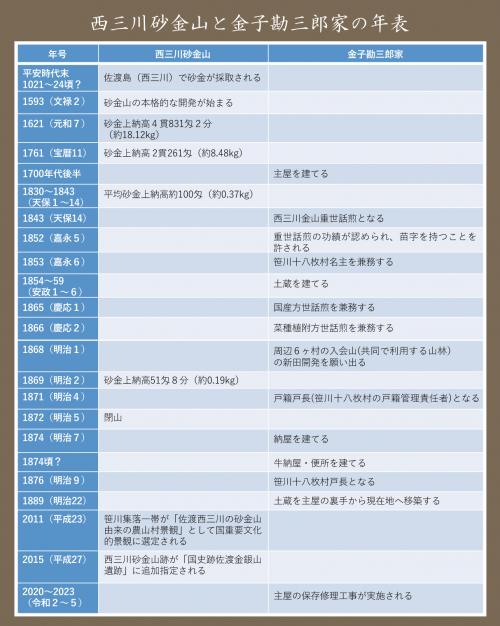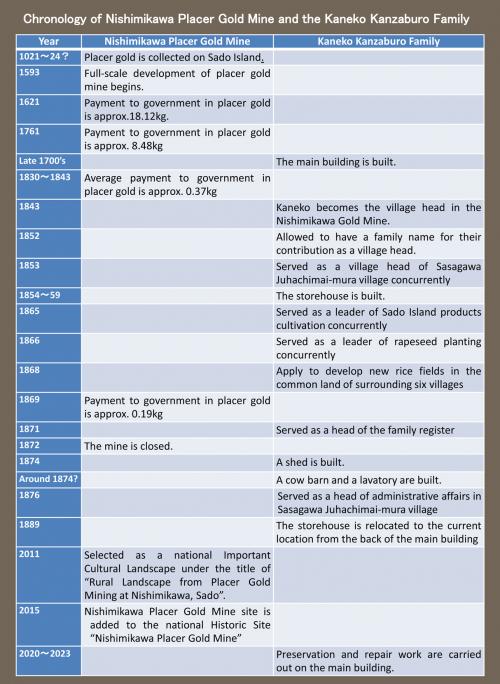本文
【金子勘三郎家】 パネル1(Part 1)
其の一 西三川砂金山の歴史と金子勘三郎家の役割
佐渡最古の西三川砂金山
佐渡島の南西部に位置する西三川砂金山(現笹川集落周辺)は、佐渡で最も古い金山として知られ、今から約1,000年前の平安時代に砂金採取が始まったとされています。
戦国時代末期の1593(文禄2)年頃から、越後の戦国大名上杉景勝による本格的な開発が行われ、大量の砂金を採取するため、「大流し」(※1)と呼ばれる技術が用いられました。当時、ひとつの砂金採取地から毎月砂金18枚(約2.9kg)を上杉氏へ納めたことから「笹川十八枚村」と呼ばれ、大変な賑わいをみせたといわれています。
江戸時代中期以降、砂金の産出量は次第に減少し、1872(明治5)年に砂金山は閉山となりました。しかし、現在でも笹川集落周辺には、大流しに利用した水路跡や堤跡、山の斜面を掘り崩した際に生じたガラ石を転用した石積みなど、かつての鉱山集落の名残をみることができます。
金子勘三郎家が務めた「重世話煎」とは?
金子勘三郎家は、1843(天保14)年から27年間、「西三川金山重世話煎」という役職を務めました。
この役職は、佐渡奉行所の出先機関である西三川金山役所のもとで、砂金の採取から上納ま でのすべての運営を行うもので、当時、非常に重要な家柄であったと考えられます。
このほか、笹川十八枚村の名主のほか、「国産方世話煎」や「菜種植附方世話煎」(※2)も兼務しており、砂金の産出量が激減していく江戸時代末期において、村の存続に向け、新たな産業開発の主導的役割も担っていました。
- ※1 大流し
- 長距離にわたり水路を引いて溜めた水を、砂金を含む山の斜面を人力で掘り崩した土砂にかけ流して余分な土砂を洗い流し、流れずに残った砂金を採る方法。
- ※2 国産方世話煎・菜種植附方世話煎
- 桑、漆、菜種などの佐渡産物の栽培促進のために、佐渡奉行所から任命された役職

Part 1 The History of Nishimikawa Placer Gold Mine and Role of Kaneko Kanzaburo Family
Nishimikawa Placer Gold Mine: the Oldest Mine in Sado
The Nishimikawa Placer Gold Mine (currently the area around the Sasagawa settlement), located in the southwestern part of Sado Island, is presumed to have had placer gold mining operations about 1,000 years ago, and is known as the oldest gold mine in Sado.
Nishimikawa was developed on a full scale by Uesugi Kagekatsu, a warlord in the Echigo Province, from around 1593. A mining technique called “Onagashi” *1 (great flow) was used to collect a large amount of placer gold. It is said that this area was called “Sasagawa Juhachi-mai mura” (literally “Sasagawa 18 mai village”; mai was a unit to count gold and silver used in the Edo period) as 18 mai (approximately 2.9 kilograms) of placer gold was paid to the Uesugi clan from a placer gold mining site, and was bustling with people.
After the middle of the Edo period, the output of placer gold in this area gradually decreased and the mine was closed in 1872. However, the atmosphere of a mining settlement still exists in the vicinity of the Sasagawa settlement, as remains such as those from waterways and reservoirs for “Onagashi” operations and stoneworks made of wastestones left over from scraping the slope of the mountain can still be seen in this area.
What is the Role of Omo-sewairi?
The Kaneko Kanzaburo family served as omo-sewairi (a village head) of the Nishimikawa Placer Gold Mine for 27 years, beginning in 1843.
The family played an extremely important role managing all the processes of running of the gold mine, from collecting placer gold to paying tax to the government under the Nishimikawa Administration Office, which was a branch of the Sado Magistrate’s Office.
In addition to their position as a village head in Sasagawa Juhachi-mai village, the Kaneko family also served as kokusankata-sewairi*2 and natane-uetsukekata-sewairi*2, and played a leading role in the development of new industries to sustain the village at the end of the Edo period, when the output of placer gold drastically declined.
- *1 “Onagashi” (great flow):
- A technique involved flushing large volumes of water that had been collected over a series of long-stretching waterways and stored in a reservoir over a valley filled with sand and earth that had been scraped down from the placer-gold containing mountainside. The immense water pressure washed away unwanted dirt and heavy stones, allowing the highly-dense placer gold to separate from the earth and sink to the bottom of the waterway, where it was collected by hand panning.
- *2 Kokusankata-sewairi and natane-uetsukekata-sewairi:
- Positions assigned by the Sado Magistrate’s Office to promote cultivation of Sado Island products such as mulberry, lacquer and rapeseed.




